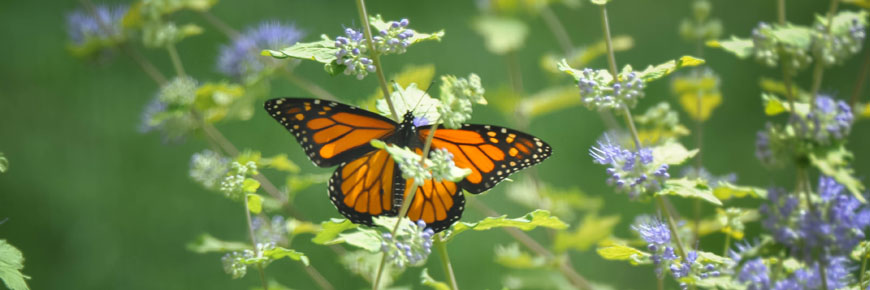
Species at risk
Rouge National Urban Park
Rouge National Urban Park is home to 42 species at risk (species considered endangered, threatened, or of special concern under federal law) and Parks Canada works hard to ensure the long-term survival of these species.
A species at risk can be classified as endangered, threatened or of special concern under the federal Species at Risk Act. A species is considered endangered if it faces imminent extinction or extirpation (local extinction). Threatened species are not yet endangered but are likely to become endangered if steps are not taken to protect them, while a species of special concern is at risk of becoming threatened or endangered. These are some of the species at risk found in Rouge National Urban Park:
Monarch butterfly
The Monarch is a species of special concern that faces threats from the use of herbicides across North America and logging in Mexico. In the fall, Monarch butterflies migrate thousands of kilometres from the United States and southern Canada to their overwintering sites in Mexico. In the spring they begin to return north. No single butterfly completes the full round trip—the overwintering generation flies to Texas before laying eggs that give rise to the next generations, which finish the northward migration. Herbicides threaten this species because Monarch caterpillars rely on milkweed plants as their only food source. Herbicide use has reduced the amount of milkweed available for the butterflies to lay their eggs on and for the caterpillars to eat. Recent efforts have been made to promote planting milkweed to provide more habitat for Monarchs.
Butternut
Butternut is an endangered tree species that is currently threatened by butternut canker, a type of fungus that infects and kills butternut trees. It can be spread from tree to tree by wind, rain, insects, and birds. The fungus causes cankers to form on the trunk and branches of the tree. As the cankers grow and join together, they cut off the flow of nutrients and water through the tree. If the cankers girdle the trunk, the tree will die. Some trees may be genetically resistant to butternut canker, which offers hope for this species.
Bats: Tri-colored Bat, Northern Myotis, and Little Brown Bat
These three bat species are all endangered due to the recent outbreak of white nose syndrome, a deadly disease caused by a fungus, likely introduced from Europe. The fungus grows in damp, cold environments such as the caves and mines where these bats hibernate. The infection disrupts the bats' hibernation, causing them to exhaust their fat reserves before the end of winter. White nose syndrome has caused some bat populations to decline by more than 90%. This disease was first detected in Canada in 2010 and has since killed millions of bats in eastern Canada and the northeastern United States.
Blanding's Turtle
These medium-sized turtles are easily identified by their bright yellow throat and chin. They are considered threatened due to issues such as habitat loss, habitat fragmentation, road mortality, and poaching. Parks Canada and the Toronto Zoo have been collaborating on a Blanding's Turtle re-introduction project, which has resulted in the release of more than 115 baby Blanding's Turtles into Rouge National Urban Park. Snapping Turtles and Map Turtles are also found in the park and are classified as species of special concern.
Milksnake
The Milksnake is a species of special concern, often found near old farm buildings and fields where mice are abundant. Milksnakes are not venomous, but are sometimes mistaken for rattlesnakes. Habitat loss, road mortality, and human persecution threaten this species.
Redside Dace
This endangered minnow is a cool water species that requires specific stream habitats. These fish have a very interesting feeding strategy—they jump out of the water to catch insects. The main threat to the Redside Dace is habitat loss and degradation due to urban development, which has led to changes in water quality and the removal of vegetation from stream banks. Redside Dace need streamside vegetation to provide habitat for the insects they eat and to keep the water cool enough for them to survive.
Chimney Swift
This small insect-eating bird has experienced significant population declines due to habitat loss. As their name implies, Chimney Swifts often build their nests in house chimneys. Suitable nesting sites are becoming increasingly rare since most new homes do not have chimneys and many traditional chimneys have been renovated for fire prevention purposes. Unlike most birds, chimney swifts cannot perch upright—they must cling to vertical surfaces inside chimneys or hollow trees.
Least Bittern
This threatened species is the smallest member of the heron family. The Least Bittern is found in cattail marshes and is sensitive to human disturbances. Habitat loss from wetland drainage, shoreline development, and invasive species are serious threats. A Least Bittern has been observed at a restored wetland in the park.
Bobolink and Eastern Meadowlark
Both of these birds nest in meadows and hayfields and are classified as threatened. Development and habitat fragmentation have contributed to the decline of these species. Parks Canada is working closely with the park’s farming community to protect these birds while ensuring that agriculture continues to thrive in the park.
- Date modified :